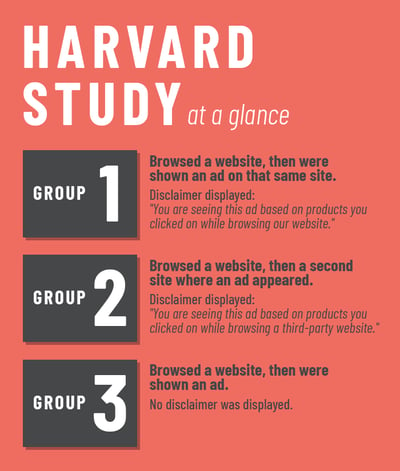
Connecting with website visitors after they have left your pages is certainly a powerful tool in digital marketing. And while consumers today are more aware of "cookie" tactics, and we might say they benefit by receiving reminders that are relevant to their interests, there is always a tipping point at which retargeting ads may be too frequent and annoying. At that point they are doing more harm than good for your brand. Here are some guidelines for keeping your program safely inside that line and not wasting impressions.
Assuming that none of us wish to provoke consumer backlash or stoke fears about data breaches, it is important to understand a few best practices related to information privacy and other matters before embarking on a Retargeting program. There are also some processes that may help you finesse your ad messaging, frequency and placement for better results.

1. Privacy Policy Page.
Do you have one? Developing a Privacy Policy page for your website is one of the first recommended practices. Your page should clearly state what information you collect, why you collect it, and how you use it. This page won’t be a specific guide for planning a retargeting campaign. But it is a good foundation to build upon because it speaks of your company’s commitment to privacy. Of course, your own legal advisor should be consulted for guidance on compliance relating to your specific business.
2. Cookie Consent Banner.
Can visitors to your website accept/reject cookies? Fast becoming a website fundamental is a banner that allows site visitors the opportunity to opt out of cookies. It has been required for European business since 2018 as part of the GDPR (General Data Protection Regulation). In addition to adding transparency about your website's intent to capture information for followup marketing, the banner also typically links to the privacy statement page for further explanation of your policies.
3. Integration with an Inbound Marketing Program
Of course, how you manage visitor preferences as well as any continuing engagement is made easier if you have an integrated inbound marketing platform. Our agency uses HubSpot. With it’s built-in compliance templates, we can easily add a consent banner and set up automated actions such as giving contacts a simple opt-out procedure or enabling them to request that their personal data be deleted.
We also use HubSpot to create landing pages which serve as destinations for ad clicks and for collecting more information to engage interested prospects. Landing pages, automated emails, contact databases and other elements of inbound marketing are central to any digital marketing program. To learn more about our Inbound Marketing services, view this brief overview:
---
Download Our Brief Overview:
What Is Inbound Marketing? How Can It Help You Close More Business?
---
4. Research Inputs
To improve acceptance of your retargeting ads and avoid overstepping, there are many valuable insights to be gained from surveys you can do yourself or with the help of others. Possible areas of investigation can run the gamut: What is the attention span of prospects for your types of products and services? What types of information are important at each stage of the buying process? And also, how sensitive and personal are the problems your products solve for users?
For certain types of products, the limits on what is acceptable and what isn’t may be common sense. For example, retargeting may be considered offensive or too sensitive on matters of personal finances, sex and certain types of health issues. In other words, a retargeting message like this would not likely be well received: “As a person interested in filing bankruptcy, you may also like this.”
The Role of Buyer Personas
Within the framework of inbound marketing, it is also helpful to establish a clear picture of buyer personas for your targeting efforts and messaging. Research as necessary to fill in any gaps in your understanding of customer types. Know how they interact with your products and services. Then plan a retargeting campaign that is relevant for targets of all types and at each stage.
Example recipe: To engage with prospects in the early stages of the purchase journey, ad messaging and website content might focus on problems/solutions and general education about what’s new in your category. In later stages, the messaging might turn to converting prospects to your brand. For example, decision-stage ads might invite downloads of brand comparison data, present links to case studies or offer promotional pricing.
5. Ad Frequency Caps
We’ve all had the experience of viewing a product online then being barraged with followup ads well beyond our interest level. With research and planning, you will be in better position to set parameters for such details as ad content and frequency as well as number of days or other length of time that a prospect will receive ads. That timing may differ for products that have a short or long consideration phase.
To make the most of ad impressions you are buying, take advantage of digital ad platforms that allow setting both the interval and total number of ads that will be served to each person. For further insight, also consider doing a split test of campaign settings to determine a combination that produces the best response.
6. Monitoring Process
As with all digital advertising, one obvious advantage of retargeting is that we can make adjustments easily. A retargeting program should be dynamic and set up with monitoring of key metrics that are important to campaign goals.
In addition to top line reporting of impressions and clicks, we watch for patterns that suggest necessary changes to the media plan or other aspects of the campaign, Once again, with an inbound marketing platform which tracks conversions on specific landing pages, that reporting can be part of a custom dashboard that is checked frequently. We can even set up instant notifications to improve response times when customers submit questions or request a personal contact.
---
Retargeting and other digital advertising is certainly not going away. Few of us really expect an ad-free internet, though as consumers we may groan about it.
Still, as we plan digital ad strategies and retargeting as part of those initiatives, it’s clear that we should strive for the right balance. Retargeting’s effectiveness is influenced by a whole host of things including level of privacy expected, where the prospects are in the purchase journey, how relevant you craft the messaging and the courtesies you extend your website visitors by planning appropriate ads and frequency.
---
A Retargeting Study You May Find Interesting
A 2018 study published by Harvard sheds more light on how retargeting may be more or less effective, depending upon context. The study explored consumers’ feelings about different ad retargeting methods and their resulting likelihood of purchase. Participants were divided into three groups and given a browsing task.
All participants were then asked about likelihood of visiting the advertiser’s website and purchasing the product advertised. Result: Purchase intent was 24% lower for Group 2 participants who knew their information was shared forward to other websites (as in retargeting).
Of course, we don’t know from the published report just how “personal” or intimate the ad subjects were. It may be reasonable to assume that purchase intent “backlash” would be more pronounced if the ads implied that a more personal browsing and clicking history was being tracked for retargeting purposes.
---
Is lead generation a core objective for your marketing? Check these free tips to rev up your lead gen strategy.



